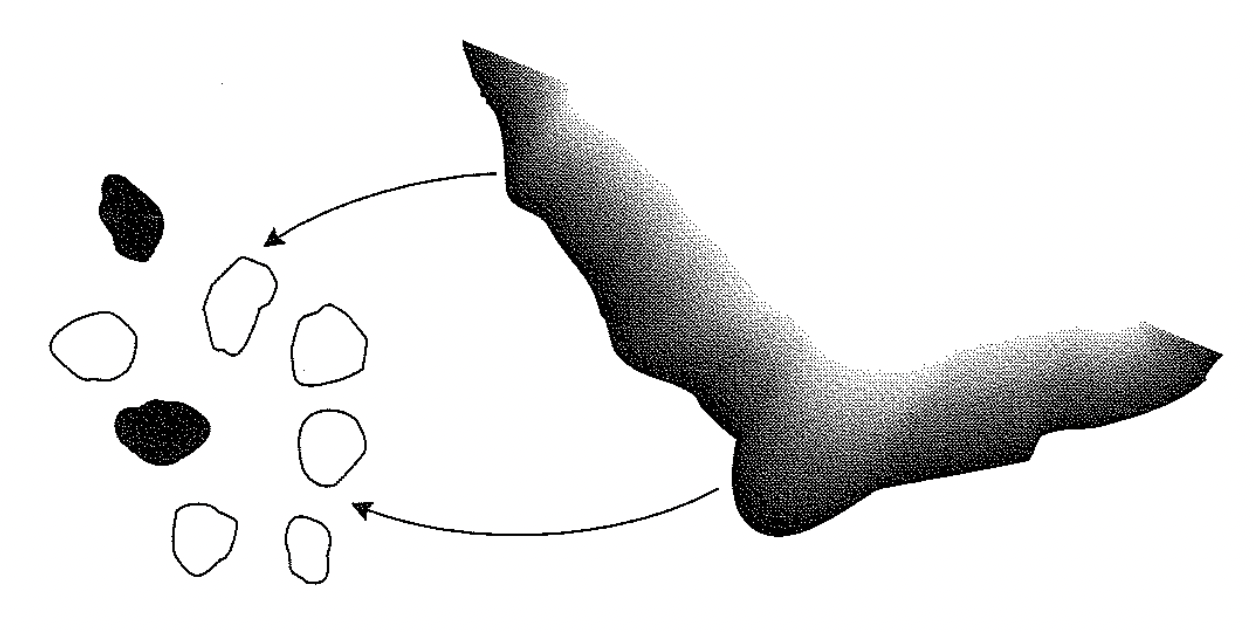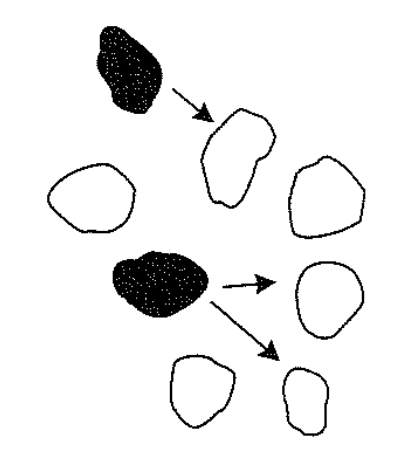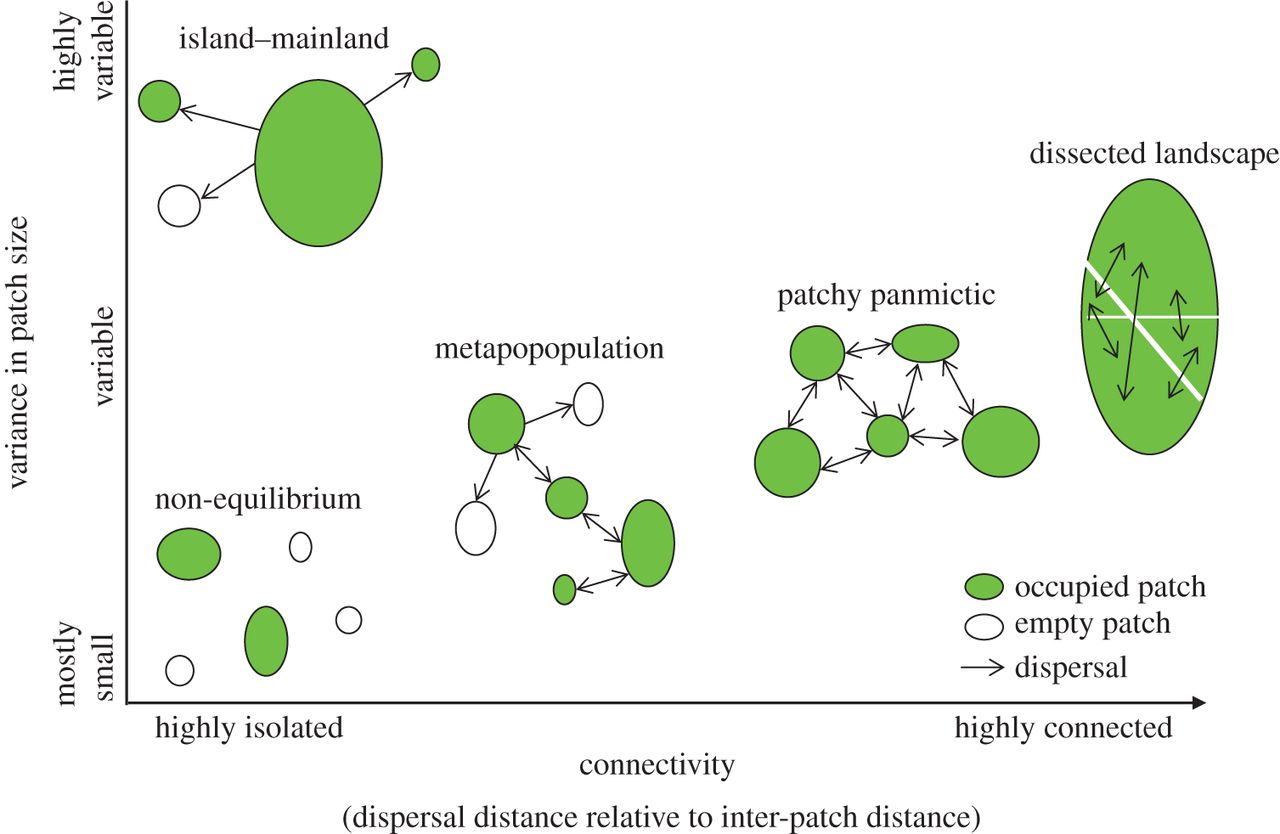Metapopulation
Daijiang Li
LSU
Announcements
Exam 1
Population dynamics so far
- Exponential growth with unlimited resource
- Logistic growth (Carry Capacity K)
- Age structures
- Closed population and dispersal
Metapopulation
The movement of individuals among sites can be potentially important to the persistence and survival of populations.
Metapopulation: population of populations (Levins 1970); a group of several local populations linked by immigration and emigration
Scaling populations to landscapes
No longer focus on number of individuals (i.e. population size); instead we focus on the population's persistence (i.e., local extinction or local persistence)
Shift to focus on regional and landscape level with many connected sites; we no longer focus on the persistence of any particular population; instead we try to understand the fraction of all population sites that are occupied
parking lot; does not care about a specific lot, but the proportion of opening/filled lots
Local vs regional extinction risk
local extinction: a single population extinct
regional extinct: all populations in a system extinct (metapopulation die out)
One population
pe: probability of local extinction, e.g. pe=0.7
probability of persistence = 1−pe, e.g., 0.3
Local vs regional extinction risk
local extinction: a single population extinct
regional extinct: all populations in a system extinct (metapopulation die out)
One population
pe: probability of local extinction, e.g. pe=0.7
probability of persistence = 1−pe, e.g., 0.3
Multiple (e.g., n=5) population
probability of regional extinction = (pe)n = 0.75 = 0.16807
probability of regional persistence = 1−(pe)n = 1−0.75 = 0.83193
Local vs regional extinction risk
local extinction: a single population extinct
regional extinct: all populations in a system extinct (metapopulation die out)
One population
pe: probability of local extinction, e.g. pe=0.7
probability of persistence = 1−pe, e.g., 0.3
Multiple (e.g., n=5) population
probability of regional extinction = (pe)n = 0.75 = 0.16807
probability of regional persistence = 1−(pe)n = 1−0.75 = 0.83193
Spread of the risk: a set of populations can persist for a surprisingly long time
Metapopulation models
Assumptions
a set of homogenous pathes
no spatial structure
no time lags: instantaneous response
constant colonization/immigration and extinction rates
regional occurrence affects local colonization and extinction rates
large number of patches
Parameter symbols in notes vs book
| Notes | Book | |
|---|---|---|
| Fraction of sites occupied | N | f |
| Colonization rate | c | pi |
| Extinction rate | e | pe |
pi: is approximately the proportion of open sites colonized per unit time
pe: the probability that a site becomes unoccupied per unit time
Metapopulation models
dfdt=I−E
Metapopulation models
dfdt=I−E
I=pi(1−f)
Metapopulation models
dfdt=I−E
I=pi(1−f)
E=pef
Metapopulation models
dfdt=I−E
I=pi(1−f)
E=pef
dfdt=pi(1−f)−pef
Metapopulation models
dfdt=I−E
I=pi(1−f)
E=pef
dfdt=pi(1−f)−pef
The above equation will serve as a template for developing alternative metapopulation models.
The island-mainland model
The equation in the previous slide is the simplest model for our metapopulation with pi and pe as constants.
- pe is a constant so that the probability of extinction is the same for each population and does not depend on the fraction of patches occupied
- pi is constant implies a propagule rain, a continuous external source of migrants

The island-mainland model
Equilibrium of f :
dfdt=0=pi(1−f)−pef
pif+pef=pi
^f=pipi+pe
Note that even with large pe and small pi (it will always be >0 because of external sources), f will still > 0, i.e. at least some of the sites in the metapopulation will be occupied.
Internal colonization (Levins model)
No propagule rain and the only source of propagules for the metapopulation is the set of occupied sites, i.e., internal colonization

dfdt=pi(1−f)−pef
pi=if
dfdt=if(1−f)−pef
Internal colonization
Find Equilibrium
set the equation dfdt=if(1−f)−pef to 0
solve f
Internal colonization
Find Equilibrium
set the equation dfdt=if(1−f)−pef to 0
solve f
if(1−f)=pef
pe=i−if
^f=i−pei=1−pei
Note: if ^f≤0, metapopulation will go extinct because no external sources
The Rescue Effect
The above two models assumed that pe was a constant and was independent of f.
pe might be affected by f because with higher f there would be more propagules that leave the site and may arrive at occupied sites to increase the local population size.
This increase in local population size N is a rescue effect that may prevent the local population from extinct due to demographic and environmental stochastics.
The Rescue Effect
The above two models assumed that pe was a constant and was independent of f.
pe might be affected by f because with higher f there would be more propagules that leave the site and may arrive at occupied sites to increase the local population size.
This increase in local population size N is a rescue effect that may prevent the local population from extinct due to demographic and environmental stochastics.
pe=e(1−f) dfdt=pi(1−f)−ef(1−f)
The Rescue Effect
The above two models assumed that pe was a constant and was independent of f.
pe might be affected by f because with higher f there would be more propagules that leave the site and may arrive at occupied sites to increase the local population size.
This increase in local population size N is a rescue effect that may prevent the local population from extinct due to demographic and environmental stochastics.
pe=e(1−f) dfdt=pi(1−f)−ef(1−f)
pi=ef
^f=pie
Neutral Equilibrium
Internal colonization + Rescue effect
dfdt=if(1−f)−ef(1−f)
Equilibrium?? No simple solution!
i>e, metapopulation grows until f=1 (landscape saturation)
i<e, metapopulation contracts until f=0 (regional extinction)
i=e, no change for f
Types of metapopulation

Four metapopulation models
| Independent pe | pe mediated by rescue effect | |
|---|---|---|
| External colonization (propagule rain) | dfdt=pi(1−f)−pef | dfdt=pi(1−f)−ef(1−f) |
| Internal colonization | dfdt=if(1−f)−pef | dfdt=if(1−f)−ef(1−f) |
Four metapopulation models
| Independent pe | pe mediated by rescue effect | |
|---|---|---|
| External colonization (propagule rain) | dfdt=pi(1−f)−pef | dfdt=pi(1−f)−ef(1−f) |
| Internal colonization | dfdt=if(1−f)−pef | dfdt=if(1−f)−ef(1−f) |
| Independent pe | pe mediated by rescue effect | |
|---|---|---|
| External colonization (propagule rain) | Island-mainland model | Rescue effect |
| Internal colonization | Levins model | Neutral equilibrium |